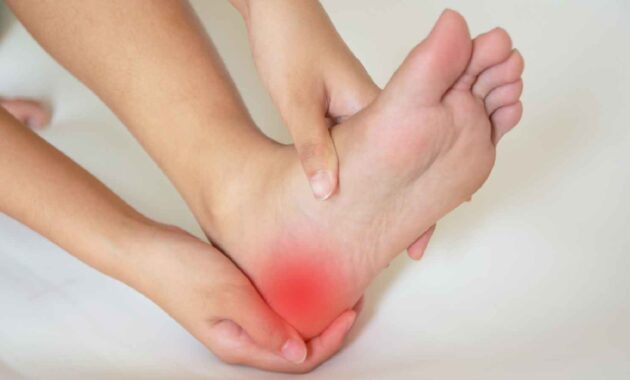Heel pain is one of the commonly occurring foot and ankle issues. The pain area can either be underneath the heel or behind it. It is a prevalent issue that can impact individuals of all ages and backgrounds. Its effects can vary from minor discomfort to severe conditions that disrupt daily life. Having a grasp of its underlying causes, identifying its indicators and being informed about prevention and treatment methods are vital for the overall well-being of your feet.
Health Shots got in touch with Dr Naga Vani, Senior Physiotherapist, Kamineni Hospitals, Hyderabad, to understand everything about heel pain.
What causes heel pain?
“Heel pain stems from various causes, each with its own set of contributing factors. Plantar Fasciitis ranks as the most prevalent culprit, originating when the plantar fascia, a thick tissue band from heel to toe, becomes inflamed or irritated. Common risk factors include overuse, obesity, inappropriate footwear, and high arches,” the expert tells Health Shots.

Here are some common reasons why your heels pain!
1. Achilles Tendinitis
Achilles Tendinitis, another prevalent source of heel discomfort, results from the inflammation of the Achilles tendon, which links calf muscles to the heel bone. This condition often arises from overuse, abrupt increases in physical activity, or tight calf muscles.
2. Heel spurs
Additionally, Heel Spurs, bony growths under the heel bone, can cause pain when they irritate surrounding tissues, often coexisting with plantar fasciitis.
3. Inflammation between the heel bone and skin
Bursitis, characterized by inflammation of the bursa sac between the heel bone and Achilles tendon or skin, is another contributing factor.
Select Topics of your interest and let us customize your feed.
PERSONALISE NOW
4. Stress fractures
Finally, stress fractures, tiny heel bone cracks due to repetitive stress or trauma, affect athletes and individuals engaged in high-impact activities more frequently.
Also read: Foot pain in the morning? Know what it means
Signs and symptoms of heel pain
Heel pain presents in various forms, ranging from mild discomfort to agonizing distress. Common symptoms of heel pain include:
• A sharp, stabbing pain that’s particularly noticeable in the morning or after rest.
• Swelling can accompany the pain, especially with conditions like Achilles tendinitis or bursitis.
• Stiffness in the heel and surrounding area often makes foot movement challenging.
• In cases of infection or severe inflammation, the heel may appear red and feel warm to the touch.
These signs and symptoms serve as important indicators of heel pain, aiding in both diagnosis and timely treatment.
How to prevent heel pain?
Preventing heel pain is a proactive approach to maintaining overall foot health, involving the adoption of healthy lifestyle habits and the consideration of specific risk factors. Here are some essential preventive measures:
Also read: Stop curling your toes with pain, and learn how to remove an ingrown toenail at home
1. Choose adequate shoes and avoid heels
“Go for shoes that provide adequate arch support, cushioning, and a comfortable fit. Avoid high heels or footwear with insufficient support, as these can exacerbate heel pain by straining the plantar fascia or Achilles tendon,” says the expert.
2. Maintain a healthy weight
The expert says that excess body weight places extra stress on the feet, contributing to heel pain. Maintaining a healthy weight through a balanced diet and regular exercise can significantly reduce this strain, alleviating the risk of heel pain.
3. Incorporate exercises that help improve strength and flexibility
“Incorporate stretching exercises regularly into your routine that can aid in improving the flexibility and strength of the Achilles tendon and calf muscles. Consulting with a physical therapist or fitness professional can provide tailored guidance on effective exercises,” says the expert.
4. Avoid sudden changes in physical activity
Avoid abrupt, intense changes in physical activity or high-impact exercises. Instead, gradually increase your activity levels to allow your feet to adapt and minimize the risk of overuse injuries that lead to heel pain.
What is the best treatment for heel pain?
When pain in the heel strikes, prompt and appropriate treatment is essential for relief. The choice of treatment depends on the cause and the severity of the pain. The right course of treatment includes:
1. Rest
“Initially, it’s crucial to allow your feet to rest, avoiding activities that exacerbate the discomfort. Applying ice to the affected area and elevating the foot can reduce inflammation and provide relief,” says the expert.
2. Physical therapy
Physical therapy is often recommended, where a trained therapist prescribes exercises and stretches to enhance foot and calf flexibility and strength. Orthotic devices, such as custom-made or over-the-counter inserts, can offer improved arch support and cushioning in your footwear.
3. Non-steroidal drugs
“Non-steroidal anti-inflammatory drugs may be advised by a doctor to alleviate pain and inflammation. In more severe cases, cortisone injections can provide relief, but surgery is typically reserved as a last resort for situations unresponsive to conservative treatments,” says the expert.
#Heel #pain #Symptoms #Prevention #Treatment
